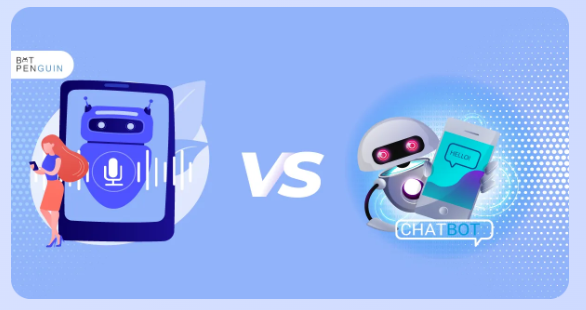AI Voice Bots Vs Text-Based Chatbots: Key Differences

Artificial Intelligence (AI) has transformed customer interaction across industries. Businesses now use advanced tools such as AI voice bots and text-based chatbots to provide round-the-clock support, improve customer experience, and streamline operations. Though both solutions are based on the same underlying AI technology, they differ significantly in functionality, user interaction, and application.
In this blog, we’ll explore the key differences between AI voice bots and text-based chatbots, helping you decide which is better suited for your business needs.
Understanding AI Voice Bots and Text-Based Chatbots
Conversational AI is changing customer interactions, with AI voice bots and text-based chatbots leading the way. While both enhance communication, their unique features and use cases make understanding their differences essential for optimising user engagement.
Before diving into the differences, let’s define the two technologies:
AI Voice Bots
AI voice bots use speech recognition and natural language processing (NLP) to understand and respond to voice inputs. These bots mimic human conversation and can interact with users in real time through spoken language.
Text-Based Chatbots
Text-based chatbots, on the other hand, communicate through written text. They interact with users via messaging platforms, websites, or apps, using predefined scripts or AI-powered language models to respond.
Key Differences Between AI Voice Bots and Text-Based Chatbots
AI voice bots and text-based chatbots are transforming customer interactions across industries, each offering unique strengths. Understanding their differences can help businesses choose the right solution to enhance user experience and meet specific needs.
| Feature | AI Voice Bots | Text-Based Chatbots |
| Mode of Interaction | Use spoken language; ideal for hands-free applications like phone support or smart devices. | Use written text; suited for web chats, messaging apps, and text-based support systems. |
| Ease of Use | Natural and accessible for users of all abilities, especially those who may struggle with typing. | Require typing, which can slow interactions but ensures clarity and precision. |
| Complexity of Responses | Handle nuanced, context-aware conversations with advanced NLP; can detect emotions and adjust tone. | Limited by character constraints and predefined scripts; better for concise communication. |
| User Experience | Immersive and human-like, though susceptible to issues like background noise or poor voice recognition. | Consistent and reliable; users can reread or edit inputs for accuracy. |
| Speed of Interaction | Faster as speaking is quicker than typing; ideal for real-time support. | Slower as users need to type and read responses; allows users to respond at their own pace. |
| Applications | Great for industries like healthcare, banking, and retail; common in call centres and voice assistants. | Popular for web-based customer support, e-commerce, social media, and FAQs |
| Cost and Development | Requires advanced development and may incur additional hardware costs. | Easier and cheaper to develop; quickly deployable on existing platforms. |
| Accessibility | Inclusive for users with visual impairments or those needing hands-free interaction. | It may be less accessible for users with disabilities but effective for those who prefer text. |
Selecting between AI voice bots and text-based chatbots depends on your business needs, target audience, and interaction goals. Let’s explore how to identify the best fit for your organization.
Choosing the Right Bot for Your Business
Advanced AI models are transforming the way businesses integrate chatbots and voice bots into their customer support strategies. These models enable seamless, intelligent interactions that enhance user experiences and streamline operations.
When deciding between AI voice bots and text-based chatbots, consider the following factors:
- Target Audience: Who are your users, and how do they prefer to interact? For hands-free convenience, go with voice bots. For tech-savvy users accustomed to chat interfaces, text-based bots may be a better fit.
- Use Case: Analyze your business needs. If you need to provide real-time support or facilitate complex conversations, voice bots are ideal. For structured tasks like answering FAQs, text-based chatbots work well.
- Budget: If budget constraints are a concern, text-based chatbots are a more affordable starting point. Voice bots require higher investment but deliver superior personalization.
- Scalability: Voice bots may require more resources for scaling across multiple languages and regions, whereas text-based chatbots can adapt more easily.
By utilising small AI models, businesses can harness cutting-edge technology to meet evolving consumer demands and stay ahead of the competition. Let’s delve into how these models are reshaping the landscape of conversational AI.
The Role of Advanced AI Models
Innovations in AI are redefining the capabilities of voice bots and text-based chatbots. Key advancements include:
- Enhanced Performance: Advanced small AI models optimise interactions, delivering smooth and natural communication across voice and text.
- Contextual Understanding: These models grasp expressions, emotions, and context, ensuring responses are accurate and personalised.
- Multilingual Support: Seamlessly handle multiple languages, making global communication more efficient.
- Improved Scalability: Easily adapt to evolving business needs, whether for localised or large-scale deployments.
- Future-Ready Solutions: Leverage cutting-edge technology to bridge the gap between voice and text channels, enabling unified customer experiences.
Explore the full potential of small ai models to elevate your business communications.
Conclusion
Both AI voice bots and text-based chatbots are integral parts of modern customer interaction strategies. While voice bots shine in hands-free, conversational scenarios, text-based chatbots are reliable for structured, text-driven tasks. Ultimately, the choice depends on your business goals, audience preferences, and budget.
With advancements in AI, businesses can even implement a hybrid approach, combining the strengths of both technologies to create a seamless customer experience. By leveraging solutions powered by small AI models, you can future-proof your customer interactions and stay ahead of the competition.





